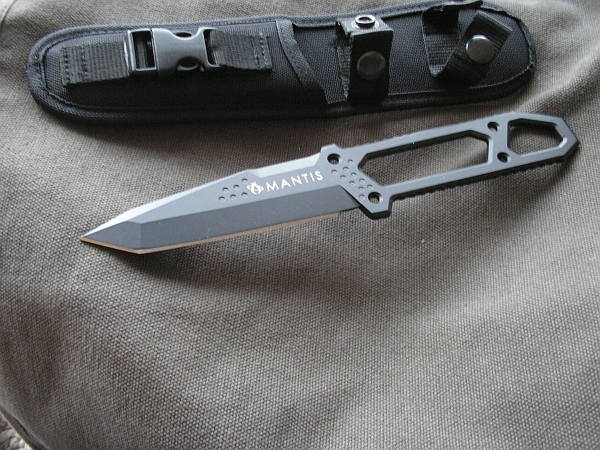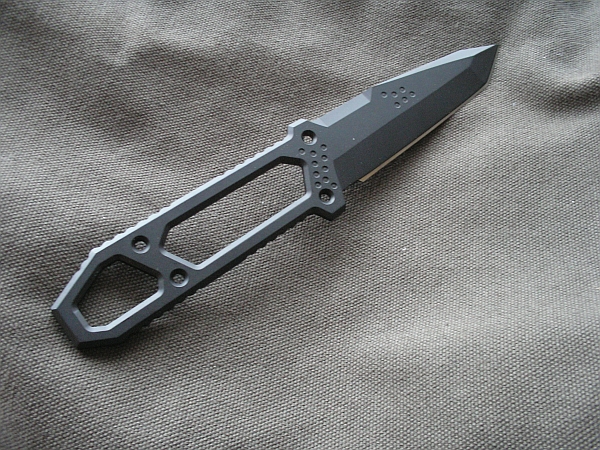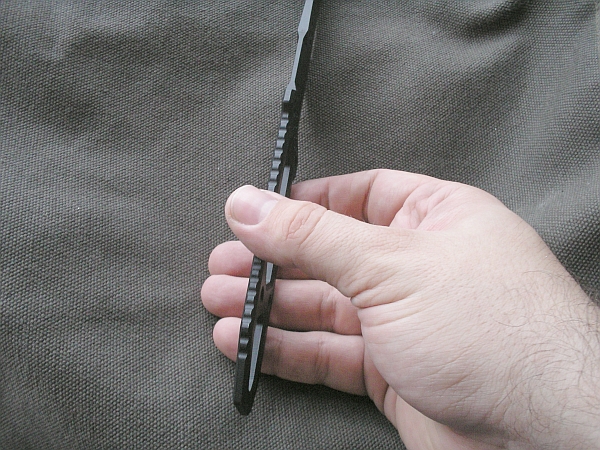Mantis Knives MF1
Review by Phil Elmore
It was in early 2007 when The Martialist first took note of Mantis Knives, a brand that seemed to appear out of nowhere in dealer catalogs and knife magazine advertisements. Contacting a real, live human being through the company's website proved surprisingly easy. We are therefore happy, after a year of living and working with these knives, to present long-term reviews of this company's blades.
 According to Jared West, owner of Mantis Knives, the company was
founded in late 2005 and debuted at the 2006 SHOT Show. "The
Mantis Logo came to me before the name did," Jared told me. "I
was sitting in an International Business class at the Hilton Business
School at L.M.U. in 2001. I was taking notes, and this logo just
hit me, so I scribbled it down. I revised it a couple of
times. Now it's the logo that you see on every Mantis Knives box
that ships out of our Anaheim Hills headquarters."
According to Jared West, owner of Mantis Knives, the company was
founded in late 2005 and debuted at the 2006 SHOT Show. "The
Mantis Logo came to me before the name did," Jared told me. "I
was sitting in an International Business class at the Hilton Business
School at L.M.U. in 2001. I was taking notes, and this logo just
hit me, so I scribbled it down. I revised it a couple of
times. Now it's the logo that you see on every Mantis Knives box
that ships out of our Anaheim Hills headquarters."
That headquarters is a 10,000 square foot facility in Orange County,
California. Some of the knives in the Mantis line are made in the
United States, while others are assembled in Taiwan from US-made
materials (sent by Mantis from Crucible and other sources). The
result is a line of affordable knives of decent quality for the money,
including the only brand of knives officially sanctioned by the United
States Catfish Anglers Tournament Series. "We're the only company
they endorse," Jared states. "We're [also] the only knife
company in the world to offer S30V stainless steel on a folder for less
than $100.00 [USD]."
Jared carries his own company's MK1 model when "hucking boxes and
working in the shop or warehouse." While out on the town, dressed
nicely, or in formal meetings, he carries "my MT2SC. It's slim,
lightweight, and elegant." Price, performance, and style are what
set his company apart from others, according to Jared. "Put our
knives to the test," he urges. "They endure. Every Mantis
knife has a unique, post-modern, industrial look to it. Ever
since I was young, I've been into strange angles and structures in
architecture and design. If I were to design a building, it would
look an awful lot like the Getty Center in Los Angels, or maybe even
the Walt Disny Concert Hall."
At just 27 years old, Jared is a young entrepreneur who seems eager to take on a competitive and often politically charged industry. Mantis' blade materials range from stainless steels like 420HC to more rugged alloys like BG42 and 154CM. Handle materials also range from unusual metal designs to more conventional G10 and carbon fiber slabs.
The Mantis MF1 "Pry Bar" is a 9.5-inch skeletonized fixed blade with a 4.75 inch blade of 420HC. The handle is drilled for the addition of a paracord wrap (not supplied) and grooved on the top and bottom surfaces for traction if you choose to use it as-is. The generous Americanized tanto blade is ground on both sides and, while my sample was not all that sharp out of the box, I was able to touch it up quickly with a dimaond rod to get it hair-popping sharp.
The knife can be wielded as-is, of course, and the skeletonized handle is not too awkward. It begs to be covered in paracord, however, which should afford a more padded, more comfortable grip. Without the paracord the knife feels slightly blade-heavy, which is not a problem in a field/survival knife (the role I foresee this blade serving most often). The integral guard is quite small but gets the job done.
The long primary point penetrated test media well, while the long straight edge sliced through rope, cardboard, and plastic without difficulty. The angle of the tanto edge is not as severe as on some knives of this type, so while the knife still does not have a true "belly" for slashing, it cuts almost as if it does. Scoring with the secondary point is not as severe as with other Americanized tantos I have tested.
The Nylon sheath supplied has a plastic insert and a simple elastic belt strap on the rear side. Two snap closures hold the sheathed knife in place. While very basic, the sheath should be more than sufficient to keep the knife in a survival kit. With some some additional straps (perhaps making use of the quick release closure on the sheath) the sheath could be strapped to a pack or other gear, too.
This is, in essence, a single piece of sharpened, contoured,
drilled metal. As such it is a very serviceable, efficient
survival kit knife or field tool. >>


